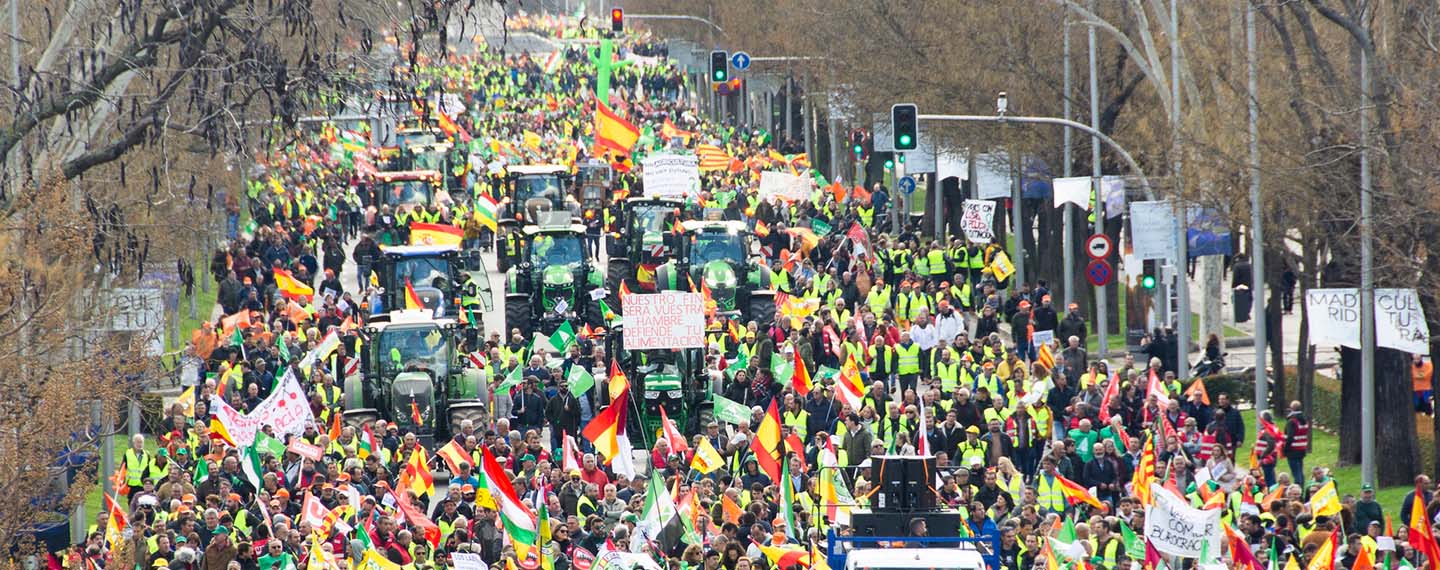Tractors driven by angry farmers have inundated Madrid and other cities as part of protests in other countries, including France, the EU’s largest agricultural producer, Greece, Germany, Poland and Portugal, against conditions that are eroding their livelihoods.
Farmers are suffering to varying degrees from falling prices (the average price of products they receive was 9% lower in the third quarter of 2023 than a year earlier), rising costs, heavy regulation, burdensome paperwork, the impact of climate change, already acute in Spain, and increasing competition, viewed as unfair, from cheap foreign imports that do not have to meet the same strict EU requirements. A common complaint is that they are expected to farm during the day and spend long evenings with burdensome paperwork.
Spain’s farmers are at the heart of what is known as ‘Emptied Spain’, the large swathes of the countryside suffering depopulation and with it inadequate services.
EU-wide agriculture generates a mere 1.4% of the bloc’s GDP, provides 4.2% of employment and receives around a whopping 30% of the EU budget. Alarm bells ring when the farming sector rebels, because of the importance of food production and the need to maintain rural communities. Spain grows one in four of the fruits and vegetables produced in the EU, more than half of the world’s olive oil and 25% of the world’s citrus fruits.
Agriculture has undergone huge change since the 1959 Stabilisation Plan during the Franco regime, which moved the country from autarky to a market economy. The sector’s share of GDP dropped from 23.5% in 1960 to 2.6% in 2022 and of employment from 39% to 3.6% (see Figures 1 and 2). More than half of merchandise exports in 1960 were agricultural (around 20% today). Yet the sector remains at the heart of life: most city-dwellers have family connections with the countryside and often second homes there. Farmers are popular.
Figure 1. GDP by sector, 1960-2022 (%)
| 1960 | 1975 | 2022 | |
| Services | 41.7 | 51.3 | 74.6 |
| Agriculture | 23.5 | 9.6 | 2.6 |
| Industry | 30.8 | 30.2 | 17.4 |
| Construction | 3.9 | 8.9 | 5.4 |
Figure 2. Employment by sector, 1960-2022 (full-time equivalent, % of the active population)
| 1960 | 1975 | 2022 | |
| Agriculture | 39.0 | 20.4 | 3.6 |
| Services | 32.1 | 44.3 | 78.2 |
| Industry | 20.7 | 24.9 | 11.3 |
| Construction | 8.3 | 10.4 | 6.9 |
Today, there are around 900,000 farms in Spain of very different size, most of them under five hectares, and around 660,000 of their owners receive some kind of EU aid. The workforce in agriculture is rapidly ageing: 41% are over the age of 65 and 4% under 35. There are also sharp regional differences: just 0.3% of jobholders in the Madrid region work in agriculture compared with 11% in Murcia. Completing this snapshot is a productivity that is well below the EU average: €1,183 per hectare in 2022 as against the bloc’s €1,433, and less than half of Italy.
Spanish farmers are particularly incensed by what they view as the non-enforcement of the law guaranteeing wholesale major supermarket buyers pay fair prices, while consumer prices have soared, and by the competition from non-EU imports, which rose 80% in volume between 2012 and 2022.
The impact of Spain’s drought is acute and prolonged. The year 2023 was the driest on record as a result of abnormally high temperatures. By the autumn, 40% of territory was in a state of drought. Nine million people are still suffering water restrictions, mainly in Catalonia and Andalusia.
Agricultural production dropped sharply in 2022, with the fall much larger than in the EU as a whole. Output last year was reportedly down again, particularly in cereals. Olive oil production was 15% higher than in 2022, but 34% below the average of the previous four years, according to estimates. High temperatures during flowering hit the quantity and quality of the blossoms.
The surging price of olive oil, a staple of the country’s cuisine, has made the ‘liquid gold’ the most stolen supermarket item this year, resulting in security tags on bottles, normally reserved for the most expensive alcoholic drinks. The price has soared from €5 a litre or less four years ago to as high as €14.
In response to the protests, the European Commission weakened last month some parts of its flagship Green Deal environmental policies, removing a recommended target to cut farming emissions from its 2040 climate road map. The map no longer includes a reference to a 30% reduction target in methane, nitrogen and other gases linked to farming, part of the measures to make the EU carbon neutral by 2050. Agriculture is responsible for 14.2% of the bloc’s greenhouse gas emissions.
A bill to halve the use of chemical pesticides by 2030 was also withdrawn, and EU farmers no longer have to set aside part of their land to foster biodiversity, under green farming measures. They will be able to continue receiving subsidies from the Common Agricultural Policy (CAP) budget by growing cash crops and nitrogen-fixing crops on set-aside land, provided pesticides are not used there.
The Commission also modified the duty-free measures for Ukrainian imports, which are due to remain until June 2025, by capping imports of sugar, poultry and eggs. The measures were first introduced following Russia’s invasion of Ukraine in 2022 to help the country’s economy, which is very dependent on agricultural products.
Spain’s farmers are at the heart of what is known as ‘Emptied Spain’, the large swathes of the countryside suffering depopulation and with it inadequate services. In all, 17 of Spain’s provinces have lost around 900,000 inhabitants in the last 20 years, while 10 others, mostly coastal but also including Madrid, have seen their population rise by 10 million, mainly lured by the vibrant tourism industry. There is no let-up in the exodus, albeit at a slower pace.
Rural dwellers are beginning to organise politically. The 2022 snap election in Castile and León –Spain’s largest region (18.6% of the country), comprising nine provinces and bigger than 17 of the 27 EU countries, but where 57% of their 2.4 million inhabitants live in just 3.4% of the territory– saw a new party, Soria ¡Ya! (‘Soria Now!’), created from the anger at abandonment by the political class, win all three seats assigned to the province of that name in the 81-seat regional parliament.
The farmers’ protests come ahead of June’s elections for the European parliament when hard-right parties are expected to gain ground. Portugal’s hard-right Chega quadrupled its number of parliamentary seats in this month’s general election to 48 and its share of the vote rose from 7.2% to 18.1%. In the case of Spain, the farmers’ discontent is a breeding ground for VOX, the hard-right party founded in 2013, which entered the national parliament in April 2019 with 24 of the 350 seats (52 in the November 2019 election and 33 in the 2023 general election), and hopes to harvest support.
The Popular Party (PP) governs 12 of Spain’s regions and in four of them –Aragón, Castille and León, Extremadura and Valencia, where farming plays a significant role– the agriculture post is held by VOX. The PP, like the Socialist-led national government, supports the United Nations’ 2030 Agenda for sustainable development, but not VOX.
Both the main parties are also in favour of free-trade agreements, such as the proposed deal between the EU and Mercosur (Argentina, Brazil, Paraguay and Uruguay), for which a political agreement was signed in 2019 after two decades of talks, but has yet to happen. President Emmanuel Macron, with one eye on June’s European elections, threw the signing of the deal last December under the tractor, because it did not offer enough environmental guarantees and the perceived downsides for French farmers.
The EU has made concessions and the protests have died down, but change is inevitable in a costly sector of declining relevance and a need for more environmentally sustainable policies.



